Capturing a moment in the wild can often unveil the most extraordinary and unusual facets of animal behavior. Some of the strangest creatures on Earth, who appear as if conjured from a fantasy realm, inhabit far flung corners of the globe. From the deep-sea dwellers with their alien-like features to the peculiar land animals that defy conventional expectations, these weird animals offer a glimpse into the incredible diversity of life.

Photos of these creatures often encourage questions about their unique adaptations and survival strategies. They spark a curious wonder about evolution’s playful hand.
For instance, the Aye-Aye from Madagascar, with its woodpecker-like long middle finger, taps on trees to find grubs. Meanwhile, the vibrant Venezuelan poodle moth, resembling a whimsical fairy, flits about, challenging our perception of moths being dull.
Many weird animals face threats from human activities and environmental changes, making some of them rare and critically endangered. Images of these unique species serve not only to pique our curiosity but also to remind us of our responsibility to protect them. Photographs stand as a crucial bridge between these creatures’ obscure lives and our human awareness, urging conservation efforts to ensure that future generations may also marvel at their existence.
The Two-Headed Turtle

In the extraordinary world of reptiles, the two-headed turtle emerges as a subject of both curiosity and bafflement. These unique animals display a rare condition called polycephaly, where they possess not one but two heads. In nature, this phenomenon is more frequently observed in turtles and snakes.
What causes such a distinctive formation? It is a result of an embryo failing to split completely into twins. Turtles, belonging to the species of reptiles, are particularly known to manifest this condition. The independent movement of each head can be both fascinating and perplexing to onlookers.
Here are some intriguing insights on two-headed turtles:
- Shell Sharing: Despite having two heads, they live within a single shell, cohabitating in a confined space.
- Survival Odds: Many often question how long these reptiles can survive. Notably, turtles like Thelma and Louise have demonstrated the ability to live healthy lives within captivity.
Fact | Details |
|---|---|
Common Occurrence | More frequent in turtles and snakes |
Life Expectancy | Can vary greatly; some live full lives in captivity |
The survival rates of two-headed turtles might evoke wonderment as it defies the odds in the animal kingdom. Each head seems to possess its own thoughts and appetite, leading to synchronized or conflicting actions while feeding or moving.
Can both heads coordinate? The interplay between the heads can lead to either harmonious or disharmonious existence, impacting their ability to perform simple tasks like walking or swimming.
These extraordinary creatures remind observers of the complexities and mysteries that nature holds. The anomaly in their appearance invites a deeper appreciation of the diversity among animals, particularly within species of reptiles like turtles.
See Related: The Marvelous World of the Flying Gecko: A Fascinating Exploration
The Flying Fish
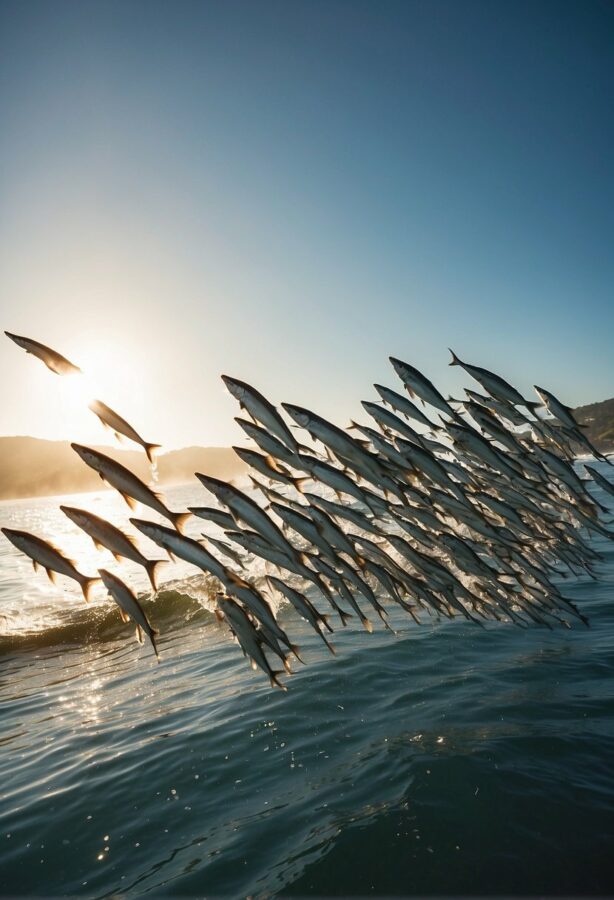
In the realm of the ocean’s many wonders, the flying fish stands out as a unique spectacle. They belong to a family of marine fish found in the world’s tropical and subtropical oceans. Known for their dazzling escapes from predators, these fish propel themselves out of the water at breakneck speeds.
Swimming Abilities:
Flying fish are not just remarkable gliders; they are adept swimmers too. Their powerful caudal fins provide the necessary thrust, launching them out of the ocean’s embrace.
Photo Fact: Did you know that flying fish can reach speeds of up to 19 mph on their aerial excursions?
Glide Dynamics:
Once airborne, the fish extend their pectoral fins, transforming into wing-like structures that facilitate their glide. These fins are a marvel of evolution, perfectly shaped to catch and use wind currents to travel impressive distances.
Photo Fact: What energy mechanisms do flying fish use to glide for up to 45 seconds in the air?
Habitat and Distribution:
These fish species grace the warm ocean waters globally. Their ability to glide is not merely a show of grace but a survival tactic to evade oceanic predators such as marlins and swordfish.
Photo Fact: How far can a flying fish travel in a single leap? The answer might surprise you: distances of 50 meters or more are quite common.
Adaptations for Efficiency:
Their gliding prowess is an energy-efficient method of travel, since it takes less effort to move through the air than water. By alternating between short bursts of swimming and gliding, flying fish maximize their momentum while conserving energy—a necessary adaptation in the vast and unforgiving ocean.
Photo Question: Could the flying fish’s exceptional gliding technique inspire advancements in bio-mimetic design in aeronautics?
The Camouflaged Owl

Owls have always fascinated animal enthusiasts with their mysterious presence and unique adaptations. Their ability to blend into their surroundings is not merely remarkable—it is a crucial survival strategy.
Habitat and Camouflage
Owls reside in various environments, from dense woods to desert landscapes. Their feathers play a vital part in their camouflage, often mirroring the colors and textures of their habitats. Imagine peering at a tree and trying to spot an owl: what seems to be bark may in fact be the feathers of a snoozing owl.
- Bark-like Feathers: Does that bark move? It might just be an owl’s wing!
Species Specifics
Different species have distinct patterns and colors, resulting in an impressive diversity of camouflage:
- Barred Owl: Striped plumage matches tree bark.
- Great Grey Owl: Flecked feathers resemble dappled light through leaves.
Behavioral Adaptations
During daylight, these animals remain motionless, blending with nature. Their eyes, often vivid and striking at night, are subdued by day to maintain their disguise.
- Stillness: Could a predator overlook an owl because it seems to be part of the tree?
Predators and Prey
The owl’s camouflage shields it from predators while also acting as a stealthy approach to unsuspecting prey during twilight hunts.
- Silent Flight: Overhead, silent wings may spell a nighttime nightmare for a mouse.
Courtship Displays
Camouflage also plays a role in courtship, where displaying the ability to meld with the environment can be a desirable trait.
- Mating Rituals: Might the mastery of camouflage attract a mate?
This concealed avian remains an enigma that prompts observers to question and explore the peculiarities of nature’s design.
See Related: The Magnificent Allure of Peacock Cichlids: A Colorful Addition to Your Aquarium
The Albino Peacock
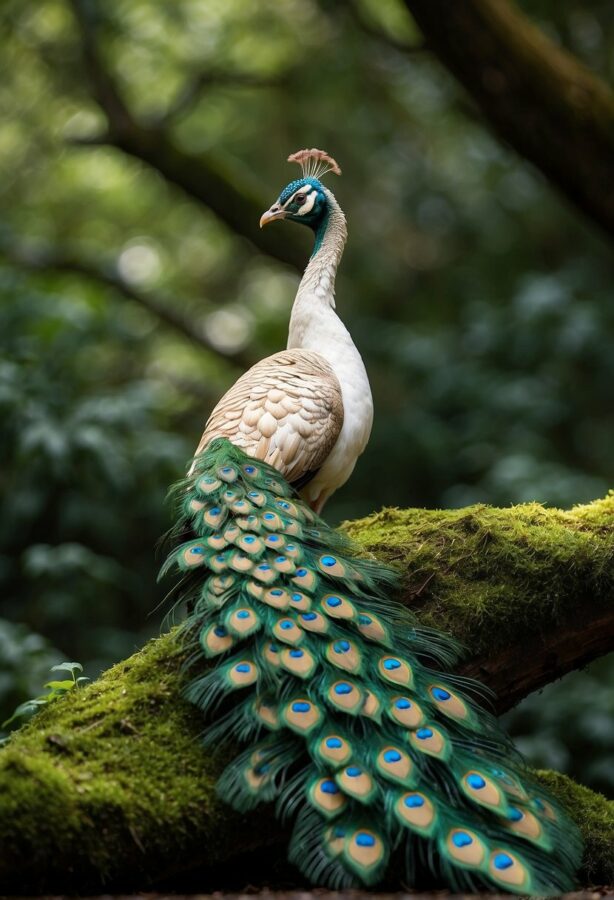
The albino peacock is a stunning anomaly in the animal kingdom. Unlike their vibrantly colored counterparts, these birds boast a pure white plumage due to a genetic mutation known as leucism – an intriguing point that differs from albinism as it doesn’t affect the eyes. Their eyes are usually normal in color and the pigmentation of their skin remains unchanged.
Diet & Habitat
- They are omnivores, feasting on a variety of items:
- Plant-based: fruits, grains, berries
- Meat-based: small mammals, reptiles, insects like ants, termites, and even scorpions.
The rarity of these birds makes spotting them a special treat for photographers and bird enthusiasts alike. They are a variant of the blue peacock, exhibiting the same species’ elaborate courtship displays. Their startling white feathers raise a curious question: How do these birds fare in their mating rituals without the typical colorful display?
Behavioral Display
- Despite their lack of color, albino peacocks still partake in the grand courtship dance, fanning their impressive tail feathers to attract mates.
Photographers often capture the mesmerizing beauty of these creatures, with each photo presenting an opportunity to ponder over the ways nature deviates from the norm. How might the starkly white feathers of these birds influence their interactions within their own species?
Conservation Status
While not a separate species, the albino peacock does not have a specific conservation status apart from the common peacock species. They are bred in captivity and sometimes found in the wild, maintaining a stable population against the backdrop of biodiversity concerns.
Photos of the albino peafowl reveal a hidden tapestry of the animal kingdom, punctuated by pure white elegance.
The Hairy Frogfish
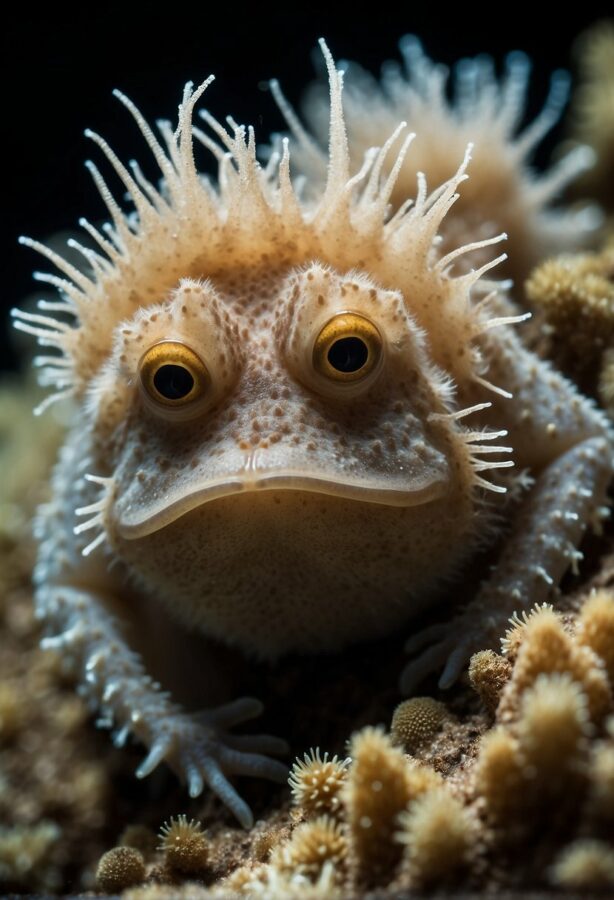
Encountering a hairy frogfish (Antennariidae family) might leave one mystified. These creatures are masters of disguise, with their body covered in spiny appendages that resemble hair, providing excellent camouflage among the ocean’s coral and seaweed. When stationary, they blend seamlessly into their surroundings, confounding both prey and predators alike.
Appearance & Behavior
- Covered in hair-like spines for camouflage
- Utilizes a fishing lure (esca) on its head to attract prey
One can’t help but wonder, how does such an unusual fish move along the ocean floor? Interestingly, hairy frogfish do not swim in the usual fishlike manner. They possess modified pectoral fins that act like legs, allowing them to “walk” across the seabed.
Feeding Method
- Lures prey with worm-like esca
- Capable of consuming prey in a fraction of a second
Did you know that the hairy frogfish’s gulp is one of the fastest eating methods within the animal kingdom? Their large mouths suck in prey almost instantaneously, making their eating process both fearsome and fascinating to watch.
Reproduction & Interaction
- Enigmatic courtship rituals
- Often solitary, yet they seek out partners during mating season
The courtship of hairy frogfish is a rare spectacle, inciting curiosity about how these solitary animals interact during their seasonal mating. Observing their behavior sheds light on the sophisticated and complex lives of these bizarre sea creatures, furthering our understanding of the diversity of life in the ocean.
The Spiral-horned Antelope
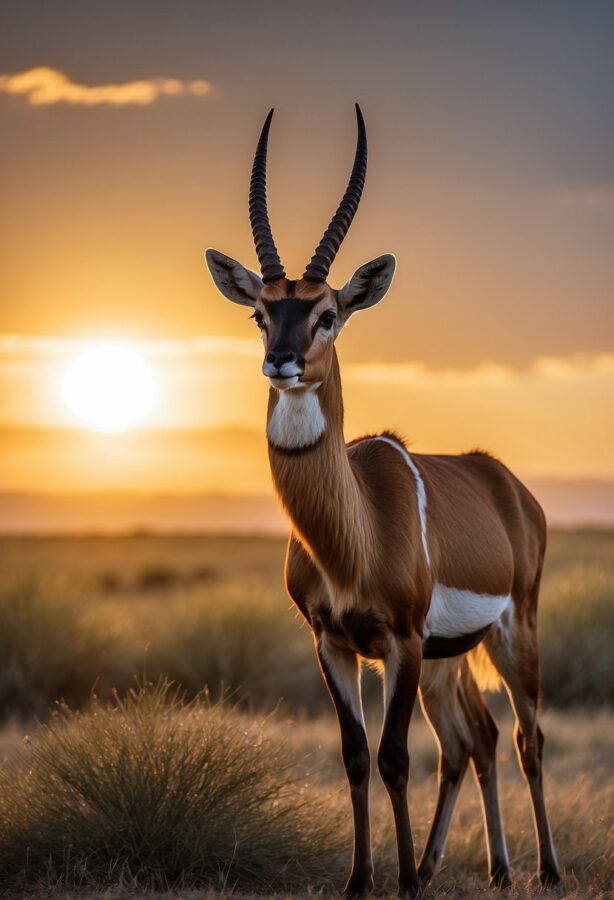
Spiral-horned antelopes are a group of mammals found on Earth’s savannas, known for their distinctively twisted horns. They belong to a subfamily called Tragelaphinae, which consists of several species each with their own unique characteristics. The horns of these animals are not just for show; they play a crucial role in the antelopes’ survival and social structures.
Notable Species:
- Nyala: Characterized by sexual dimorphism, males sport long, spiraled horns up to 65 cm, while females are hornless.
- Eland: Holding the title as the world’s largest antelope, eland bulls have significantly heavier and longer horns with more spirals, used for clashing over mates.
Adaptations:
- Sitatunga: With the peculiar adaptation of splayed and split hooves to navigate their swampy homes, they exhibit remarkable semi-aquatic abilities.
Photos of these antelopes strike curiosity as each reveals nature’s ingenious adaptations. For instance:
Did You Know:
- Spiral-horned antelopes exhibit a wide range of horn shapes, from the lyre-like curves of the bushbuck to the grand spirals of the kudu.
- Their twisted horns are not just ornamental; they are critical for defense against predators and competition for mates.
With each species of spiral-horned antelope adapted to thrive in diverse habitats across Africa, their captivating horns bring forth a sense of wonder about the evolutionary paths that led to such distinctive traits.
See Related: Finger Monkey Size: How Big Does a Finger Monkey Get and What to Expect
The Meditative Monkey
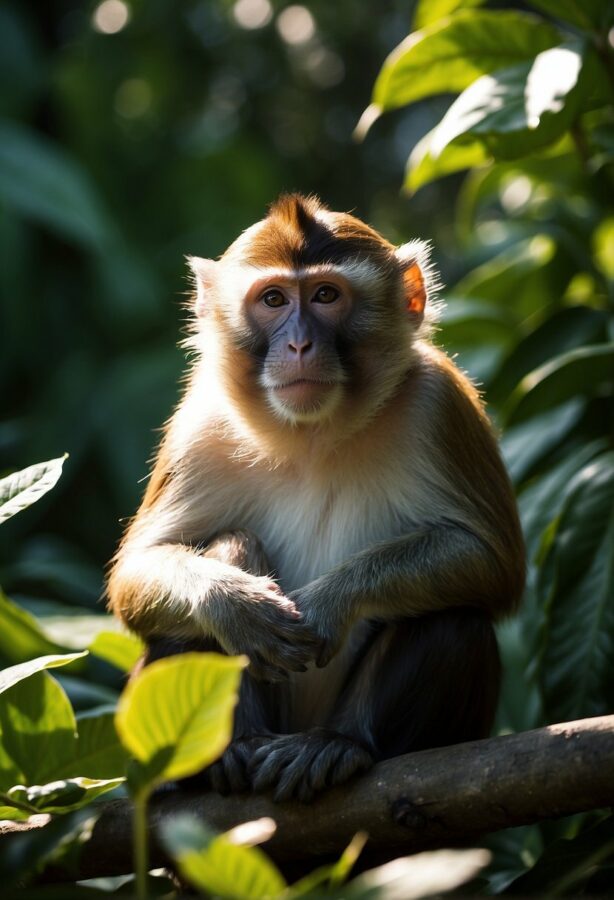
Monkeys, known for their playful pranks and clever tricks, have often been captured in photographs that spark both amusement and curiosity. Among these images, some stand out for showcasing primates in unusually tranquil poses, as if they were engaged in meditation. These photographs not only provide a moment of levity but also elicit questions about the cognitive world of these animals.
Their Affinity for Stillness
Are they imitating humans, or is there a natural propensity for stillness in the primate world? While it might be tempting to humanize the monkeys’ behavior, scientists believe that these moments of quietude could indeed be part of their natural behavior, especially in species that display high levels of cognitive and social complexity.
A Moment on Earth
One striking image depicts a monkey serenely handling what appears to be a plastic bottle—an allusion to the impact of global waste on animal habitats. Do they recognize the bottle’s significance, or is it mere curiosity? It highlights the intersection of wildlife and the escalating issue of pollution on Earth, sharply reminding viewers of the fragile coexistence of animals and humans.
Species and Sanctuaries
The monkeys captured in these enigmatic poses often belong to species dwelling in rainforests, some of which are endangered. Monkeys, being vital components of these ecosystems, serve as ambassadors for conservation efforts. By fostering a connection through imagery, viewers can become inspired to support the preservation of primates and their rainforest homes.
Captured Moments
In essence, the ‘meditative monkey’ photos may not just be showing a quirky, peaceful primate. They could invite a deeper reflection on the subjects they depict—our fellow inhabitants of this Earth, whose lives are inextricably linked with the health of the environment and the actions of humankind.
The Upside-Down Bat

Bats evoke a sense of curiosity and, for some, tingles of a nightmare with their nocturnal flights and association with folklore. These fascinating creatures are the only mammals capable of sustaining flight, and their unique way of life can sometimes be captured in bewildering photos.
Hanging Habit: One of the most remarkable aspects is their habit of roosting upside down. Unlike birds, bats cannot launch into flight from a stationary position. Thus, by hanging upside down, they make use of gravity to drop into the air and take flight.
Echolocation Excellence: Bats also boast an extraordinary way of navigating in the dark: echolocation. With this biological sonar, bats emit sounds and listen to the echoes that bounce back, constructing a mental map of their surroundings. A photo capturing the bat mid-echo can be surreal, as if the creature is whispering secrets to the night.
Species Intrigue | Fact or Question |
|---|---|
Fruit Bat | Did you know these gentle giants have a wing span up to 1.5 meters? |
Vampire Bat | Have you ever wondered how these bats locate the right spot to make a tiny incision for their blood meal? |
Bats’ upside-down posture isn’t just a quirk; it’s a survival tactic, an adaptation that has allowed them to thrive across various species, from the insect-loving little brown bat to the fruit-gobbling flying fox. Their photos may seem bizarre, but behind each image is a story of evolution and adaptation that enables these mammals to fill important ecological niches.
See Related: The Appetite of Sharks: Unveiling What Lies on Their Menu
The Smiling Shark
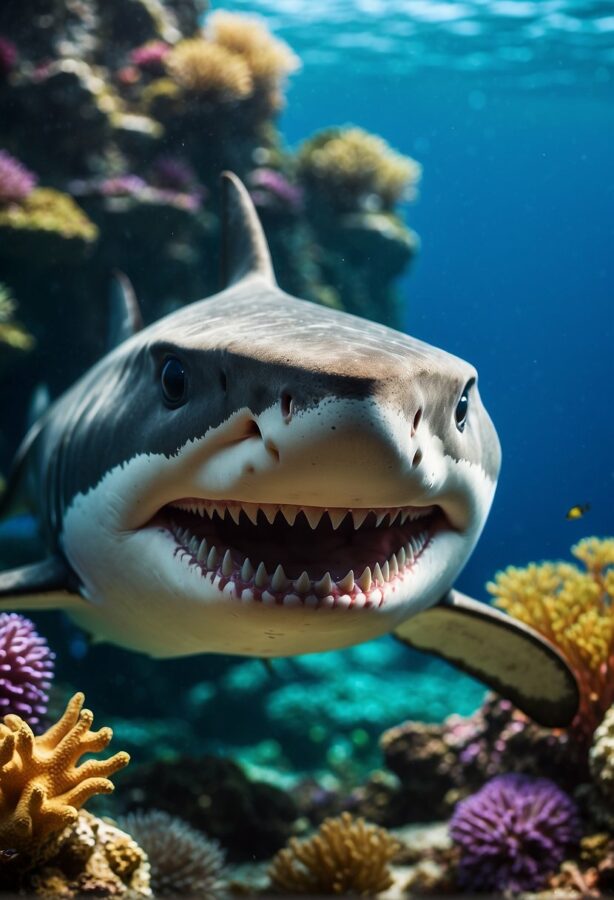
Sharks, with their notorious reputation in the oceans, are the subject of both fear and fascination. One particular aspect that tickles curiosity is the phenomenon of “smiling sharks.” Despite the term, these marine animals do not smile in the human sense; the shape of their jaws and positioning of teeth can sometimes give this misleading appearance.
The Ninja Lanternshark, a relatively recent addition to the shark family, has a notable expression. This species was named Etmopterus benchleyi in honor of the author of “Jaws.” They are small in size and possess an enigmatic grin. But one might wonder, what’s behind their glow-in-the-dark features?
- Smiling Shark Photography: They capture the contrast between the frightening image sharks typically hold and the unexpected, seemingly lighthearted expressions some species display.
- Intriguing Fact: Some species, like the Great White, have teeth designed for shearing, giving a ferocious look. Yet, here they seem almost amiable. Is it a trick of the lens, or is there more to a shark’s smile?
A table of Smiling Sharks commonly featured in photography:
Shark Species | Notable Feature | Expression Gleaned |
|---|---|---|
Great White Shark | Razor-like teeth | ‘Grinning’ Predator |
Lemon Shark | Mellow yellow appearance | Mild and ‘Friendly’ |
Hammerhead Shark | Distinctive head shape | Quirky ‘Smile’ |
Captivating images of these fish challenge the common perceptions of sharks. Each photo, whether showing sharp teeth or unusual features, serves to deepen the intrigue surrounding these ocean inhabitants. They remind viewers that animals, even ones with formidable reputations, can be seen in a different light – sometimes all it takes is a camera angle or a play of light to spark questions about the true nature of these aquatic species.
The Color-changing Cuttlefish
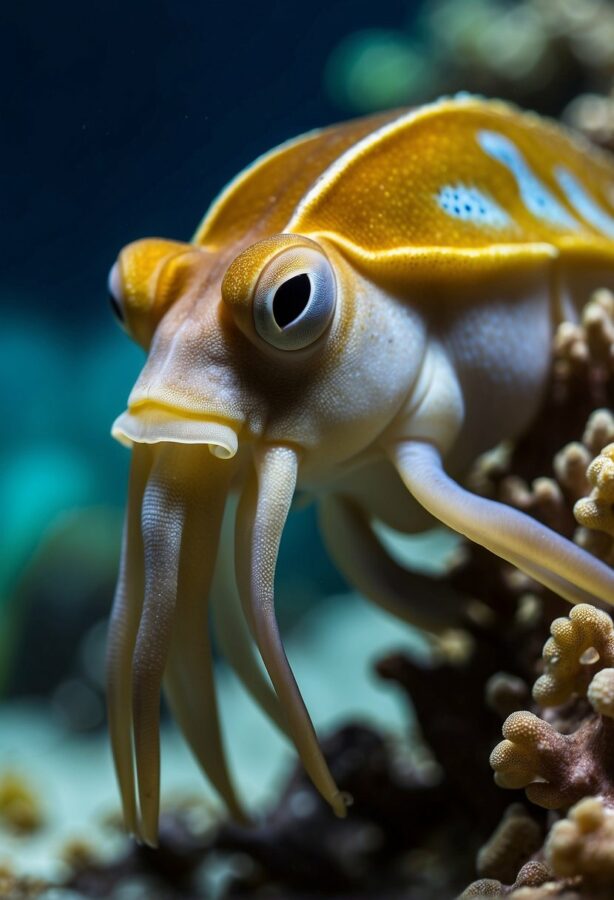
Cuttlefish are marine animals of the order Sepiida, known for their remarkable ability to change color. This color change functions as both camouflage and a means of communication. They possess an outer layer of skin laden with pigment cells called chromatophores, which expand and contract to produce various hues, patterns, and textures.
Photo 1: A cuttlefish blending into a coral reef
Did you know that cuttlefish can see polarized light, helping them detect contrast in their ocean environment?
Within their skin, the cuttlefish also have other specialized cells, such as iridophores, which reflect light, creating an iridescent sheen, and leucophores, which scatter light, appearing white. Together with chromatophores, they create a dynamic display of coloration. Their skin changes in a fraction of a second, thanks to direct neural control.
Photo 2: Cuttlefish displaying vibrant colors during a mating display
How do cuttlefish select colors when they’re colorblind?
Cuttlefish are active predators, and their camouflage helps them sneak up on prey or hide from potential predators in the diverse habitats of the ocean. These mollusks use their skills not only to hide but also to imitate other oceanic objects, making them masterful mimics.
Photo 3: A cuttlefish imitating the texture of a rock on the seabed
Can you spot the cuttlefish, or is it just another stone?
The phenomenon of changing color is one of the various adaptations that make cuttlefish a fascinating species. Their ability to swiftly alter their appearance is unparalleled in the animal kingdom, revealing a complex relationship with their surroundings.
Related Resources: